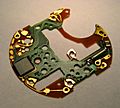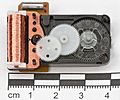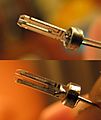Quartz clock facts for kids
A quartz clock is a special kind of clock that uses a tiny, vibrating quartz crystal to keep time. Imagine a very small, super-accurate electronic heartbeat! This crystal vibrates at a very steady speed, and that steady beat helps the clock measure time precisely.
Because of this amazing crystal, quartz clocks are much more accurate than older, mechanical clocks. Since the 1970s, they have become the most common way we tell time, from your wristwatch to the clock on your wall.
Contents
How Quartz Clocks Work
Quartz clocks use a clever system to tell time. Here's how it generally works:
The Quartz Crystal
The heart of a quartz clock is a small piece of quartz crystal, often shaped like a tiny tuning fork. When you send electricity through this crystal, it vibrates at a very specific and steady rate. For most clocks, this rate is 32,768 times per second (32,768 Hz). This steady vibration is like a perfect, unchanging rhythm.
Counting the Vibrations
The clock has an electronic part called an electronic oscillator. This oscillator makes the quartz crystal vibrate. Then, a tiny computer chip inside the clock counts these vibrations. It's like counting every single beat of the crystal's rhythm.
Making Time Move
Once the chip counts a certain number of vibrations, it knows that one second has passed. It then sends a signal. In a digital quartz clock, this signal changes the numbers on the screen to show the new time. In an analog quartz clock (with hands), the signal powers a tiny stepper motor. This motor moves the gears, which then move the second, minute, and hour hands around the clock face.
Why Quartz Clocks Are So Accurate
The main reason quartz clocks are so accurate is the quartz crystal itself. Its vibrations are incredibly stable and don't change much, even with small changes in temperature. This means the clock keeps a very consistent beat, leading to very precise timekeeping.
History of Quartz Clocks
The idea of using quartz crystals for timekeeping started a long time ago.
Early Discoveries
Scientists discovered in the late 1800s that quartz crystals could produce electricity when squeezed (this is called the piezoelectric effect). Later, in the early 1900s, they learned that if you applied electricity to quartz, it would vibrate at a very steady frequency.
First Quartz Clocks
The first quartz clock was built in 1927 by Warren Marrison and Joseph Horton at Bell Telephone Laboratories in the United States. These early clocks were huge, often filling entire rooms, and were used mainly in scientific labs to keep very precise time.
Making Them Smaller
Over time, engineers found ways to make the quartz crystals and the electronic parts much smaller. This led to the development of the first quartz watches in the 1960s, which became widely available and affordable in the 1970s. This made accurate timekeeping accessible to almost everyone.
Images for kids
-
A circuit board from a chronograph wristwatch. The quartz oscillator crystal is on the right.
-
The basic parts of a quartz wristwatch. The quartz crystal oscillator is at the bottom right.
See also
 In Spanish: Reloj de cuarzo para niños
In Spanish: Reloj de cuarzo para niños








